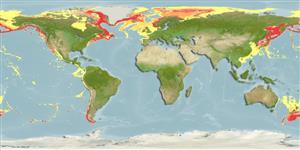Ctenodiscus crispatus (Retzius, 1805)
Cookie-cutter seastar| Native range | All suitable habitat | Point map | Year 2050 |

|
| This map was computer-generated and has not yet been reviewed. |
| Ctenodiscus crispatus AquaMaps Data sources: GBIF OBIS |
Upload your photos
Google image |
No photo available for this species.No drawings available for Goniopectinidae.
Google image |
No photo available for this species.
Classification / Names Common names | Synonyms | CoL | ITIS | WoRMS
Asteroidea | Paxillosida | Goniopectinidae
Environment: milieu / climate zone / depth range / distribution range Ecology
Benthic; depth range 10 - 2200 m (Ref. 119490). Polar
Distribution Countries | FAO areas | Ecosystems | Occurrences | Introductions
Circumpolar to New England on the Atlantic and to Panama and Japan in the Pacific. Polar to tropical regions.
Length at first maturity / Size / Weight / Age
Maturity: Lm ? range ? - ? cm
Same depth range from Ref. 119523.
Life cycle and mating behavior Maturity | Reproduction | Spawning | Eggs | Fecundity | Larvae
Members of the class Asteroidea exhibit both asexual (regeneration and clonal) and sexual (gonochoric) means of reproduction. Life cycle: Embryos hatch into planktonic larvae and later metamorphose into pentamorous juveniles which develop into young sea stars with stubby arms.
Main reference
References | Coordinator | Collaborators
Piepenburg, D., N.V. Chernova, C.F. von Dorrien, J. Gutt, A.V. Neyelov, E. Rachor, L. Saldanha and M.K. Schmid. 1996. (Ref. 2952)
IUCN Red List Status (Ref. 130435: Version 2024-1)
CITES status (Ref. 108899)
Not Evaluated
CMS (Ref. 116361)
Not Evaluated
Threat to humans
Human uses
| FishSource |
Tools
More information
Trophic Ecology
Ecology
Population dynamics
Life cycle
Distribution
Human Related
Aquaculture profile
Stamps, Coins Misc.
Stamps, Coins Misc.
Outreach
Taxonomy
References
Internet sources
BHL | BOLD Systems | CISTI | DiscoverLife | FAO(Publication : search) | Fishipedia | GenBank (genome, nucleotide) | GloBI | Gomexsi | Google Books | Google Scholar | Google | PubMed | Tree of Life | Wikipedia (Go, Search) | Zoological Record
Estimates based on models
Preferred temperature
(Ref. 115969): 0.3 - 6.2, mean 1.9 (based on 1501 cells).
Price category
(Ref. 80766):
Unknown.


